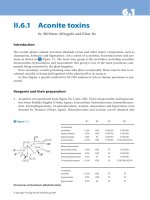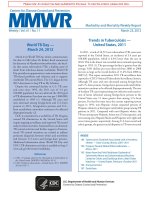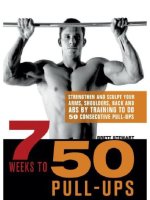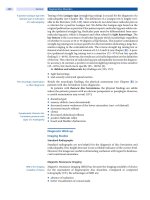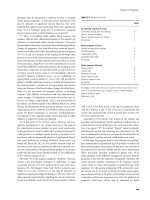51 contest prep peak week
Bạn đang xem bản rút gọn của tài liệu. Xem và tải ngay bản đầy đủ của tài liệu tại đây (558.13 KB, 28 trang )
UNIVERSITY
Contest Prep
Peak Week
Lesson Overview
•
•
•
•
•
•
•
•
•
•
•
•
•
•
•
•
•
What peak week is and isn’t
Peak week variables to manipulate
Carb loading the big player
Why water and sodium are needed for loading
Water manipulation and regulation
Root causes of water retention
Peak week stress management
Flat vs Full vs Spilled
Monitoring and Analysis
Carb loading methods:
Eat up into show
Back load
Front load
Training during peak week
Show day what to do?
Peak week supplementation
Sample peaking protocols
What Peak Week Is and Is NOT
Peak week is typically a one-week period prior to competition to bring
about the final look of a full and hard physique to stage
This is not a magic week and no “tricks” are here to bring an
unconditioned physique in stage ready
This is NOT the week to introduce variables you have not practiced with
prior on prep
You MUST be fat free stage lean prior to peak week
Peak week will be slight manipulations to gain 1%, but extreme
approaches can make you 10-20% worse as well.
Big Picture if you are in contest conditioning and look great 1 week out
you have very little to do, and likely best practice is to just walk out on
stage as is.
Peak week is an Art not a Science
Peak Week Variables
Physiological Changes to Meet Aesthetic Goals:
Increase muscle fullness by increasing muscle glycogen content
Bring a hard look by minimizing extracellular water
Maximizing V taper via managing abdominal bloating and fullness
Variables to be aware of:
Carbohydrates
Water
Electrolytes (Sodium, potassium)
Fiber
Food Sources
Supplements
Meal timing
Training/Cardio
Stress
Sleep
Step Count
PEDS/Fat burners
Carb Loading the Big Player
Manipulating Carbohydrates is the MAIN Variable to improve your
physique and should be the focus.
Carbohydrate Loading Practice in Bodybuilders: Effects on Muscle
Thickness, Photo Silhouette Scores, Mood States and Gastrointestinal
Symptoms (Wilson, 2019)
• 24 male bodybuilders (Amateur South American Arnold Classic or
Brazilian Championship)
• Control <5g CHO after 24 hour weigh in
• Carb load 8-12g CHO after 24 hour weigh in
• Muscle girth, thickness improved in CHO loading group only
• Panel of Bbing judges rated loading CHO group; visually improved
compared to low CHO intake
• Abdominal pain, bloating, flatulence, ab- dominal rumbling, heartburn,
constipation, and diarrhea were more often reported for athletes of the
CHO loading group
Carb Loading: We need Water and Sodium
Fullness = Carbohydrate + Water:
• Water follows carbs and sodium we need both to fill out. Each gram of
glycogen attracts 3-4 grams of water with it. (Olsson 1970)
• Cutting or reducing water early can potentially decrease the ability to
carb up and stay full, during carb loading an increase of water could be
justified.
• Cutting water early may run the risk of going flat and dehydrating the
muscle, dehydration decreases muscle water.
• Once a muscle is glycogen loaded it can maintain that load for up to 5
days. (Goforth 1997)
Fullness=Carbohydrate + Sodium
The glucose transporter in the gut (SGLT1) require sodium, so cutting
sodium can hamper carb uptake and digestion, bloating occurring (Crane
1961)
Cutting sodium can cause acute decreases in blood pressure and
vascularity (Stachenfeld 2008)
Issue With Water Manipulation for Water
Retention
Early water cuts are also quickly
accounted for by the antidiuretic hormone release from
the pituitary gland and
aldosterone release from the
adrenal glands.
These are triggered by increase
in sodium concentration in the
serum (decrease in water
or/and increase in sodium).
These hormones respond
quickly, and we see counter
regulation of water balance in
combat sport athletes cutting
water within hours not days
((Reale 2017)
This makes long duration water
tapers over days unjustified
Issue With Water Manipulation for Water
Retention
Decreasing water outside the cell will decrease water inside the cell. (Costill 1976)
The Old School Thought:
Loading sodium, then cutting it while then increasing potassium
Rationale:
There is more sodium outside (extracellular) the cell and more potassium inside
(intracellular) the cell.
Drop sodium and increase potassium will pull water inside the cell.
The Issue:
Anti Diuretic Hormone and aldosterone react quickly not only to low serum sodium but also
high serum potassium causing water reabsorption.
Diuretics only further this process by increasing sodium and potassium loss. Rare instances
these agents may be in place but are last resort options and typically only used in enhanced
bodybuilding.
Reality:
Cutting water and sodium only creates a double whammy of a drop in blood pressure, lack
of carbohydrate uptake, lack of water in the muscle resulting in flat and zero pump on stage.
Water and electrolyte balance is tightly regulating for nerve signaling needed for all organ
(lung, heart) function, you can’t “trick” survival mechanisms
Solve the Root Causes for Water Retention
NO body fat = Low subQ water (get Shredded!)
Water retention for all:
Cortisol
• High stress from mental and physical components
• Address lifestyle and training
Water retention in enhanced bodybuilding:
Estrogen management
• Exogenous androgens can create increases in estrogen leading to water
retention.
• Androgen to estrogen ratio
• Aromatase Inhibitors
Aldosterone management
• Certain compound (testosterone and Nandrolone) increase aldosterone
more than others
• Removal of potential compounds via stack redesign
• justification for water manipulation in this athlete
Pre-Peak Week Stress Management
Keep routine when planning travel (same time schedule, sleep schedule)
Scope the location (Where is hotel, gym, tanning and show) be
convenient
Hotel have microwave, fridge or kitchen?
Pack your food and shop less
Cook all meats and freeze in pre portioned baggies
Bring frozen veggies
Bring cooked rice or frozen precooked
Bring extra empty water jugs through TSA
Pack your tools of the trade
pump up bands
body weight scale
Extra Tupperware
Pack dark sheets and towels for hotel and loose clothes for tanning
Posing suit
Music to relax
Sandal and warm clothes for backstage
Peak Week Monitoring and Analysis:
Flat vs Full vs Spilled
Monitoring
7 days to 3 days out
• Visuals: take picture AM, post training and PM
• Scale weight: at time of pics
2 days to 0 days out
• Visuals: take picture AM, prior to each meal and PM
• Scale weight: at time of pics
Subjective Data:
Hunger?
Bloating?
Can you get a pump?
Should we monitor blood glucose?
Focus on visuals over all other variables
Peak Week Monitoring and Analysis:
Flat vs Full vs Spilled
Analysis FLAT VS FULL VS SPILLED
• use this throughout the week and on show day
• Find the visual and weight that looks full and hard together
• Glycogen will hold water in the cell. Which also means water outside the cell for
fluid balance. Serum glucose will rise once loaded but this is likely too late, so don’t
monitor
• We can accept some fullness and water increase, find the balance
Scale weight as a gauge:
• Scale weight increase and look harder: perfect you are full and still dry (carb
amount correct)
• Scale weight increase and look softer: full, but likely spilled over (reduce carb
amount, slight pump workout or posing)
• Scale weight decrease and look harder: carb increase decrease cortisol and shed
water, if full (carb amount correct)
• Scale weight decrease and look softer: Still flat (increase carb amount)
• When you find that best look note the carb, fluid and sodium amount and repeat
that meal, then reassess
Other tips:
• Flat will feel like you are flexing, and nothing happens
• Full will feel like the muscle cramps when flexing or a pressure is present
• Flat looks: small and smooth FULL looks: big and harder SPILLED looks: bigger and
smooth
Constructs of Peak Week
Body Fat
Skinned Lean
Carbohydrate manipulation
CHO loading is main component that will change the look of the
physique
Water and sodium manipulation
Should be minimized and held high all week for carb loading
No water or sodium loading, or tapering will be done
Water manipulation must be acute and only within hours if needed
Acute increase in sodium cause raise blood pressure and
increase muscle pumps great for just prior to stage
Diuretic
usage is a roll of the dice and not recommended
Water Retention
Address Estrogen, Aldosterone and Cortisol
LOADING METHODS:
EAT UP INTO THE SHOW
Ready 1-4 weeks out in advance
Ideal, but not always possible
Benefits:
• Drop fatigue by training volume reductions
• Increase food
• Improving energy availability
• Improved digestion, sleep, hormone profile
• More predictive glycogen fullness than rapid loads
• Regain lost muscle tissue
• You essentially are peaked before peak week
How to do it:
• Move calorie to maintenance by increase carbs 10-20g and fats 0-5g (5%
kcal increase) and assess every 3-4 days and repeat if look is improving
• Reduce cardio by 5-10 minutes per session or steps by 1000-2000 per
day every week
• Food sources stay the same
• Water and sodium stay the same, which should be a high level all prep
• If weight gain occurs, watch the visuals closely
LOADING METHODS:
BACK LOAD
1-3 da ys out from the s how
Benefits:
•
•
•
•
•
More ti me dieting
More predictive: Uti lize already ga thered refeed data for day a nd time to peak
*s ee Contest Prep: Ca lorie Cycl ing Lecture on refeeds
Ideal to use a fter doing “Eating up i nto the s how”, you just need a small carb amount to gain a touch more fullness
Ideal if you must make weight for a weight class
How to do it:
Ga uge based on your previ ous refeeds
Ca rbohydrates 1-3g/lb of body weight, some may need much higher
Lower protein and veggies content to keep digestion quick and bloating down
1 da y out remove all veggies
Fa ts can s tay s tatic, unless ca rbohydrates needs are so high you need more calorie density to hold l oad
After l oad/refeed day, return back to baseline diet maintenance i f needed
7 da ys out i ncrease water by 25% a nd salt meals same (prepare for load)
On l oa d/refeed days keep s odium normal for a refeed day you pra cticed (typically s alt i s in proportion of food vol ume),
s odium back to normal on other days
Ra pid loading ca n uptake potassium quickly a dd in s ome potassium foods (potato, banana)
La s t meal add i n fats to hold l oad if overnight if large weight drops and flat l ooks is seen upon waking
Examples:
2 da ys out: 1 da y refeed, 1 day “dry” out, then show day peaked
2 da ys out: 2 da y refeed, 1 day “dry” out, then show day peaked
1 da y out: 1 da y refeed, then show day peaked
Eating into the show and then a back load is my personal preferred method. I see it is
more predictable than a front load
LOADING METHODS:
FRONT LOAD
5-7 Days out from the show
Essential 2 peaks, 1st load glycogen and spill (upregulate enzymes), then taper down and “dry’ outs, then a 2nd
smaller load to top off glycogen again.
Benefits:
• More time to correcting spilling than with a back load
•
•
•
•
Might generate the fullest look
If severally depleted and need more days of loading
Weight class is no issue
Ready only on time and not early
How to do it:
• Gauge based on your previous refeeds
• Carbohydrates 1-3g/lb of body weight, some may need much higher
• Lower protein and veggies content to keep digestion quick and bloating down
• 1 day out remove all veggies
•
•
•
•
•
Fats can stay static, unless carbohydrates needs are so high you need more calorie density to hold load
After 1st load/refeed day, return back to baseline diet
Body weight will come down you will find the “dry” look
The second load will be one day out with a smaller increase in carbohydrate likely ½ that of the first load
7 days out increase water by 25% and salt meals same (prepare for load)
• On load/refeed days keep sodium normal for a refeed day you practiced (typically salt is in proportion of
food volume), sodium back to normal on other days
Example:
7-6 days out: 1 day refeed, 5-2 days out “dry” out, 1 day out slight refeed, show day peaked
Training During Peak Week
Goals:
• Continued stimulus to store glycogen
• Decrease in fatigue (peripheral and central)
Resistance Training:
• Deload week
• NO depletion workouts (you are already depleted)
• Training volume will likely already be very low, no set reductions needed
• Spread volume out over all days of peak week unless already training daily
• Avoid muscle failure, 1-2 RIR
• Rep range 8-15
• NO new exercises this week (especially traveling to train) = novelty means muscle
damage
• Last training session can be done 2 days out, can be upper only or full body circuit
Cardio:
• This is about energy balance and fatigue management
• Taper cardio at start of week if able
• weight class restricted
• more days needed dieting
• 2 days out no cardio
• 1 day out no cardio only posing between meals
Last Training Session Sample
Full Body Circuit:
• 2 rounds
• 12-15 reps
• RIR 3-5
• 1-2 minute rest between lifts
Exercises:
• Leg press
• Machine chest press
• Pull down
• Lateral raise variation
• Chest braced machine row
• Tricep push down
• Bicep curl
SHOW DAY:
Prejudging
Upon waking you should look close to ready and just need to hold the look
Wake up take pics and assess visuals and scale weight
I find most drop water and wake up lighter and tight
If not using diuretics and water manipulation we should have a predictive look
Previously we found the scale weight you look best at
We can watch visuals and the scale to maintain that look
Upon Waking:
• Glycogen load can be held easily on your maintenance calories amount
• Plan for the diet the day prior with water and sodium the same
• Water Manipulation
• If you a re at your best look first thing AM, reduce water between meals, same water with meals
ã Thi s might be 1/3 to ẵ normal water i ntake between meals
•
•
•
•
•
Keep in mind shows are unpredictable with stage times, cutting water out might get you flat
Get in as many meals as you did to achieve your best look, this might mean early wake up time
Stay the same
Drop out veggies
Lower protein intake
Prior to Stage:
• Last meal can be no protein only carbs and fats and double your salt intake (acute blood pressure
rise)
• Water can be stopped 45 min prior to stage to limit bathroom usage
• Prior to pump up ẵ teaspoon salt in a shot of water
ã Wait to pump up when you are in line (pushups and band circuit is plenty)
SHOW DAY:
Finals
Post prejudging replace fluids lost by body weight change from last
weigh in pre stage to post stage weight body weight (lost 2lbs = drink
32oz water)
Continue normal meals and water and sodium for rest of day, repeat
pre stage meal for finals and double sodium
Assess your pics and decide if you look full or a little flat. continue
same plan if full, if flat increase carbs
Peak Week Supplements
•
•
•
•
•
•
•
•
•
•
•
Gas X for gas and bloating
Dulcolax laxative in cases of constipation via flight
Antacids
Hyland’s Leg Cramps
Herbal Diuretics: yet to say much change from them, no need for them
General Multi mineral supplement, start 7 days out
Caffeine tablets can increase diuresis and help last days of peaking
Sleep aids (melatonin, Benadryl)
Last health supplement dosage can be taken 1 day out
Creatine monohydrate and performance supplements can stay in place
Whey protein can stay in place if using all prep
PEDs
• Yohimbine cut 7 days out
• Clenbuterol cut 3 days out
• Last injections 5-7 days out to limit inflammation
• All oral AAS, thyroid and AI can continue through show
• Continue all health supplements and take last dosage 1 day out from the show
• Diuretics will not be covered here as most are not needed and a worse look is
presented
SAMPLE BACK LOAD STRUCTURE
Days out
Water
(gallon)
Sodium
(tsp)
CHO (g)
Pro (g)
Fats (g)
Diuretic
Cardio
Training
5
Norma l
norma l
Ba s e Plan/Low
Ba s e Plan
Ba s e Plan
n/a
Norma l
Legs
4
Norma l
norma l
Ba s e Plan/Low
Ba s e Plan
Ba s e Plan
n/a
1/3
reducti on
Pus h
3
Norma l
norma l
Ba s e Plan/Low
Ba s e Plan
Ba s e Plan
n/a
1/3
reducti on
Pul l
2
Norma l
Increase per 100-120%
refeed ay
refeed
norm
Sa me per
refeed
Sa me per
refeed
n/a
off
Pump
Workout
1
Norma l
Increase per 70-100% refeed Sa me per
refeed
da y
refeed
norm
n/a
off
Off
Show
Norma l or
l i mit based
on hol ding
wei ght a nd
vi s uals
Refeed
norm + ½
tea spoon
pri or to
pump up
Sa me per
refeed (last
mea l add fats
to hol d load)
Sa me per
refeed
n/a
off
off
50-100% refeed Cut protei n
da y. 2-3 mea ls 1/3 to ½ for
pri or to s tage
di s tention
Olympia 2020 Back Load
John Jewett
Days
out
Body
wt
(lbs)
Water
(gallon)
Sodium
(tsp per
meal)
CHO
(g)
Pro
(g)
Fats
(g)
Diuretic
Cardio
(steps)
Training
5
211.8
2.5
1/8
125
300
22
n/a
15200
Back
4
210.8
2.5
1/8
125
300
22
n/a
15000
Shoulder
3
212.0
2.5
1/8
125
300
22
n/a
15500
Arms
2
211.8
2.5
1/8
125
300
22
n/a
13000
Upper
1
210.0
2.5
1/8
250
270
trace
n/a
6000
Off
Show
211.8
3/4
¼ to 1/2
180
170
trace
n/a
5000
off
SAMPLE FRONT LOAD STRUCTURE
Days out
Water
(gallon)
Sodium (tsp)
CHO (g)
5
Norma l
Increase per
refeed norm
4
Norma l
3
Pro (g)
Fats (g)
Diuretic
Cardio
Training
100-120% refeed Sa me per
da y
refeed
Sa me per
refeed
n/a
Norma l
Legs
Increase per
refeed norm
70-100% refeed
da y
Sa me per
refeed
Sa me per
refeed
n/a
Norma l
Pus h
Norma l
norma l
Ba s e Plan/Low
Ba s e Plan
Ba s e Plan
n/a
1/3
Pul l
reduction
2
Norma l
norma l
Ba s e Plan/Low
Ba s e Plan
Ba s e Plan
n/a
1/3
Pump
reducti on Workout
1
Norma l
Increase per
refeed norm
100-110% refeed Sa me per
da y, ba sed on
refeed
l ook
Show
Norma l or
l i mit based on
hol ding
wei ght a nd
vi s uals
Refeed norm +
½ tea spoon
pri or to pump
up
50-100% refeed
da y. 2-3 mea ls
pri or to s tage
Sa me per n/a
refeed
(l a st meal
a dd fats to
hol d load)
Cut protei n Sa me per
1/3 to ½ for refeed
di s tention,
no veggi es
n/a
off
Off
off
off
OLYMPIA 2020 1 DAY OUT DIET
WATER: 2.5 (315oz) GALLONS PER DAY
SALT: 1/8 TEASPOON SALT TO ALL MEALS
CHO
3oz chicken
9:30 AM 200g egg whites
140g rice,cooked wt
1 rice cake
PRO
FAT
Kcal
0
0
40
11
24
21
4
0
0
0
0
0
between meal 50oz
water
subtotal
Meal 2
6oz chicken, breast cooked wt
12:00 PM 140g rice,cooked wt
51
0
40
49
42
4
0
0
0
400
between meal 50oz
water
subtotal
Meal 3
6oz chicken, breast cooked wt
3:00 PM 140g rice,cooked wt
40
0
40
46
42
4
0
0
0
344
between meal 50oz
water
subtotal
Meal 4
6oz chicken, breast cooked wt
5:30 PM 140g rice,cooked wt
40
0
40
46
42
4
0
0
0
344
between meal 50oz
water
subtotal
Meal 5
6oz chicken, breast cooked wt
8:00 PM 140g rice,cooked wt
40
0
40
46
42
4
0
0
0
344
between meal 50oz
water
subtotal
Meal 6
6oz chicken, breast cooked wt
10:00 PM 140g rice,cooked wt
40
0
40
46
42
4
0
0
0
344
Meal 1
subtotal
TOTALS
40
CHO
46
PRO
251
0
FAT
279
344
KCAL
0 2120
